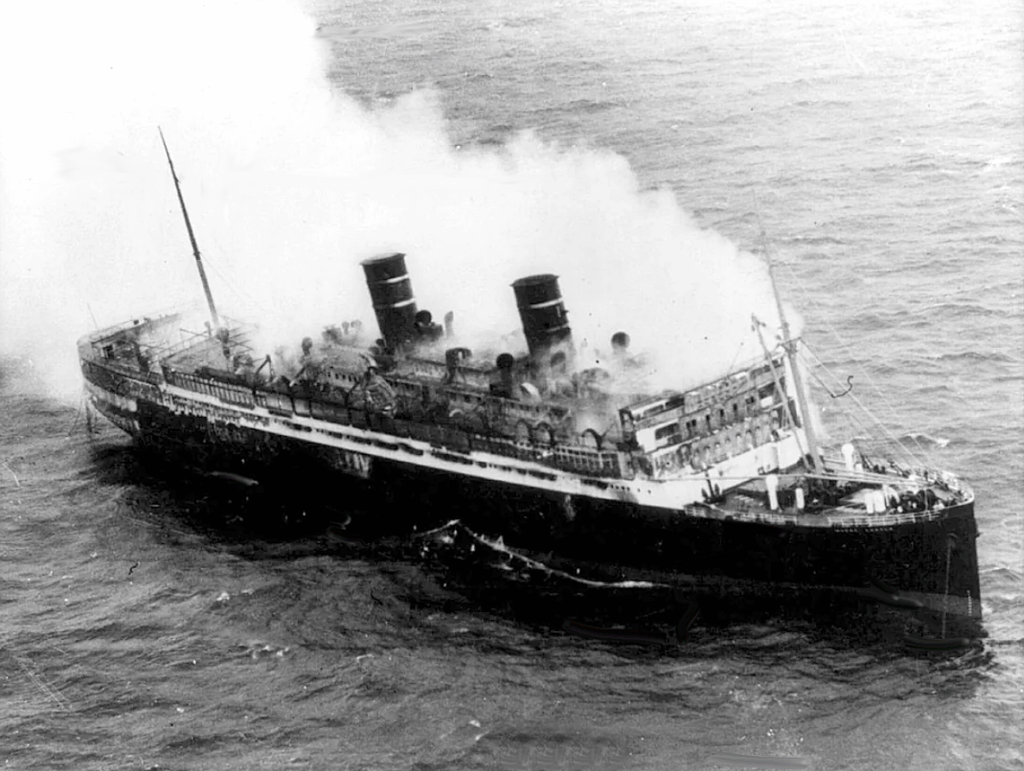The Ward Line’s 480-foot-long luxury cruise ship, SS Morro Castle, made regular runs between New York City and Havana, Cuba, in the 1930s. On her maiden voyage in 1930, she made the 1,100-mile run in 59 hours. Even though the trips were during the Great Depression, the ship was popular. It was Prohibition, but you could drink legally once in international waters.
On September 5, 1934, the SS Morro Castle left Havana on her regular run to New York under the command of Captain Robert Rennison Willmott. The voyage was entirely uneventful until two days later, when winds shifted to the east and increased with intermittent rain squalls. That evening, Captain Willmott felt ill and had dinner delivered to his quarters. Willmott complained of stomach pain and not long after, died of an apparent heart attack. Command of the ship passed to her Chief Officer, William Warms.

At 2:30 am on September 8th, a fire in a storage locker on B Deck was discovered. The fire spread quickly and within 30 minutes, most of the ship was engulfed in flames. As the fire grew in intensity, acting Captain Warms decided to try and beach the ship on the coast of New Jersey, only eight miles away. He had to abort that plan when it became obvious the fire was too intense. He decided to abandon ship.
Things went from bad to worse quickly as the fire burned through the ship’s main electrical cables, plunging the Morro Castle into darkness. With all power gone, the ship lost steering and radio. The radio operator, George White Rogers, was only able to send one SOS signal before the radio stopped working. The deck became too hot to stand on and the thick black smoke made breathing difficult. Passengers were forced to decide whether to jump or burn. The prospect of jumping into an angry ocean at night was fraught with peril.
Some of the crew showed incredible bravery as they tried to fight the fire. In the confusion and darkness, only six of the ship’s 12 lifeboats were launched, even though they had a capacity to carry 408 people; they only held 85, most of whom were crew. Many passengers died because they didn’t know how to use the life preservers.
The response by the crew, the United States Coast Guard, and rescue vessels was slow and inefficient. By mid-afternoon, the Morro Castle was abandoned and the survivors landed on the shore of New Jersey by an assortment of craft. 137 passengers and crew perished in the disaster. The Morro Castle itself would drift northward along the Jersey Shore before running aground close to the Asbury Park, New Jersey Boardwalk and Convention Hall.
There she lay like a giant dead whale, her insides exposed for all to see. The ship became a major tourist attraction, complete with sightseeing trips, postcards, and souvenirs. It was shallow enough that one could wade out and touch her. Her grim story attracted the morbidly curious. She was finally towed to Baltimore on March 29, 1935, and scrapped.
Acting Captain Warms, Chief Engineer Eban Abbott, and Ward Line Vice President Henry Cabaud were indicted on various charges relating to the fire, including willful negligence. All three were convicted and sent to prison. Later, on appeal, an appeals court overturned Warm’s and Abbott’s convictions.
The cause of the mysterious fire on the Morro Castle was never discovered. A theory that it was a deliberate act of arson by a crew member was investigated, but could not be proven. The suspected crew member was George White Rogers, the ship’s radio officer. Captain Wilmott, before his death, confided to some crew members that he suspected Rogers of wanting to murder him and destroy the ship. Turns out, Rogers had a long criminal history and years later was convicted of attempted murder with an improvised explosive device. Then, in 1954 Rogers was convicted of murdering a couple for money. He died three years later in prison.
Did George White Rodgers set the mysterious fire aboard the Morro Castle to cover up the murder of Captain Robert Wilmott? Wilmott’s body was destroyed in the fire, so no autopsy was ever done. Or was the death of Captain Wilmott an unfortunate coincidence? Rogers never confessed to either crime and it is doubtful the mystery will ever be solved.
The devastating fire aboard the Morro Castle led to many new regulations that greatly improved shipboard fire safety. Today, the use of fire-retardant materials, automatic fire doors, and ship-wide fire alarms is a direct result of the Morro Castle disaster. The disastrous loss of life also led to more attention on training, fire drills, and lifeboat procedures. In 2009, a memorial to the victims, rescuers and survivors of the Morro Castle disaster was dedicated in Asbury Park, New Jersey.
